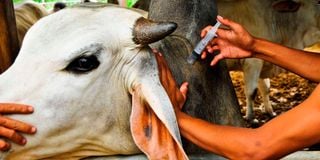Premium
When your heifer limps on all fours

Cows being vaccinated against foot and mouth disease. Animals with the disease drool thin clear saliva, which foams at the lips and corners of the mouth.
Imagine waking up to be told your cow is limping on all four legs, yet the animal was in top form when you bid it good night. I had never seen it before but it happened three weeks ago.
When I checked my phone, after completing a surgical operation, I saw that my employee Francis had called seven times.
I hadn’t completed reading his WhatsApp message when he sent a video of my most favourite pregnant heifer.
I had asked him about the animal the previous evening and he had sent me a short clip of it looking healthy, fully fed and walking gracefully.
In the new clip, however, the heifer appeared miserable. The back was arched, head lowered and it was reluctant to put weight on any of its legs.
The animal was limping on all legs but the right front was the most affected. The scene of a cow limping on all legs at the same time is awkward. The animal attempts to step on one leg but quickly lifts it, only to repeat the motion with the next leg that touches the ground.
To maintain balance and ensure minimum weight is carried on the legs, the animal arches the back and lowers the head. Such an animal obviously looks sick.
In addition to the locomotion and postural issues of the heifer, Francis said the cow was not eating, was drooling and tearing.
He wondered what had happened that night. Francis went to the extent of suggesting that the cow must have eaten a frog.
Poisonous frogs
I discounted his suggestion and informed him that cows do not go looking for frogs to eat. They only ingest the poisonous creatures if they happen to be chopped up inadvertently in fresh fodder.
Furthermore, we had never seen any poisonous frogs on the farm and frog poison does not cause limping in cattle.
Francis told me all the other 11 cattle of different ages and stages of production were doing fine.
I asked him to check the interdigital space and see if there was any injury or reddening of the skin between the hooves.
As I expected, Francis said the skin between the hooves was whitish and there was no warmth or pain on touch.
There were no injuries on the hooves. Under normal circumstances, it is very unlikely to find a cow getting injured on all four hooves or getting infected.
Only one or two hooves will show infection overnight.
I further instructed Francis to feel the lymph nodes or glands on the front and hind legs by touching them the way I had trained him. He reported the nodes were not swollen and were not painful on touch.
Finally, I asked him to check the consistency of the saliva by extending the saliva string and to check if there was any reddening or wounds on the gums and tongue.
Francis said the saliva was thick and mucous-like. The gums and tongue had no wounds and looked their normal pink colour.
I concluded the heifer needed to be examined by an animal health service provider who could, in addition to the examination I had guided Francis to do, check the heifer’s temperature and general facial demeanour.
That would help differentiate the two diseases I remotely suspected.
I called Kihara, the paravet who treats my cows, and asked him to check the animal. He did so three hours later and told me he had arrived at a tentative diagnosis of bovine ephemeral fever (BEF).
My suspicion had been BEF or foot and mouth disease (FMD).
Kihara’s physical examination showed painful joints, a lower-than-normal temperature of 37.5 degrees Centigrade and sticky saliva that emanated from the space between the gums and the lips.
His other findings agreed with what Francis had reported.
I concurred with Kihara and we agreed he treats for BEF. The lower than normal temperature, sticky saliva and painful joints indicated BEF was the problem and not FMD.
Animals with BEF will initially have a high fever of up to 41 degrees Centigrade and then drop to slightly below normal body temperature.
Animals with FMD drool thin clear saliva, which foams at the lips and corners of the mouth.
They also constantly keep licking their lips and muzzles. As the disease progresses, FMD patients develop blisters and wounds in the lips, muzzle, gums, tongue and hooves.
Anti-inflammatory drugs
Kihara treated the heifer with antibiotics and anti-inflammatory drugs. My heifer recovered by the third day and started eating and moving with normal body posture.
The animal had lived to the name of the disease.
BEF is also called the three-day-sickness because in most cases, animals recover fully on the third day with or without treatment.
However, antibiotics and anti-inflammatory treatment is recommended to limit nerve and muscle damage by the virus that causes the disease or by lying down for animals that are unable to stand during the three days of sickness.
Three-day-sickness is a disease of cattle and buffaloes caused by the bovine ephemeral fever virus.
It is spread by ticks and biting flies. The disease has no specific cure. It can be prevented through vaccination but the vaccine is not available in Kenya.
BEF rarely kills and most deaths are due to injury if the animal attempts too hard to stand up or gets injured when going down.
The disease may cause abortion and weight loss. Cows that get infected in their early and mid lactation have severe milk drop while those in late lactation mostly dry up.
Pregnant animals and those in good body condition tend to be affected more severely than lean animals.





